The George Black Ferry splashed into the Yukon River shortly after 2:00 p.m. on May 15, bringing to life the summer time link between the two Dawsons. There’s the main town on the east side of the river and then the satellite communities of Sunnydale and West Dawson on the west side.
For a few years in the mid-1990s these were all part of Dawson City proper, a response by the territory’s Municipal Board to Dawson’s request to extend its boundaries south along the Klondike Highway as far as the Dempster Corner.
A few years later the territorial government was petitioned to take back the land. People realized it was difficult to properly administer a town without a fixed link, like a bridge or a ferry.
Why is there no bridge after 116 years? It’s hard to say. The current ferry (minus some later upgrades) was brought here in 1967, and the reportage on its arrival, as recorded in the Edmonton Journal that July, was uniformly negative.
The ferry was really brought in to help transport asbestos ore from the mine in Clinton Creek, which was due to begin production that fall. At its height, Clinton Creek would have a population of about 500, roughly what Dawson had the year the ferry arrived.
The Cassiar Asbestos Corporation offered to cover half the cost of building a bridge across the river, which would have had a price tag of around $3 million, but the Yukon Government bought a $25,000 ferry boat instead. Annual operating costs would eventually rise to around $1 million.
The Mayor at the time was a retired RCMP officer named Jimmy Mellor. He had been a territorial councillor for several terms in the 1950s, and was quoted as saying that the government lacked “the foresight to build a bridge instead of wasting money on a ferry.”
Similar arguments would pop up during the remainder of the twentieth century, and until the early part of this century, when the Yukon Party government came close to actually do the deed. By then the cost had multiplied by 10 or more and there was no mining company offering to split the expense.
As is often the case with large projects in Dawson, there was some debate over where to put the bridge. Some people, like about half of the West Dawson residents, didn’t want it built.
Ironically, it was the booming world economy (just two years before the global recession of 2008) that increased the projected cost of building the bridge (originally pegged at $25 to $30 million) to the point where the government backed away from the project.
At any rate, the ferry is back in the water now, and will run 24 hours a day at roughly 15 minute intervals, between mid-May and mid-September, after which it will run twelve hours a day until it is pulled from the river some time after Thanksgiving. Lately, this usually happens after October 20, and has been as late as November 11 in the last decade. As with many things in the Klondike, a lot depends on Mother Nature.
After 32 years teaching in rural Yukon schools, Dan Davidson retired from that profession but continues writing about life in Dawson City.




